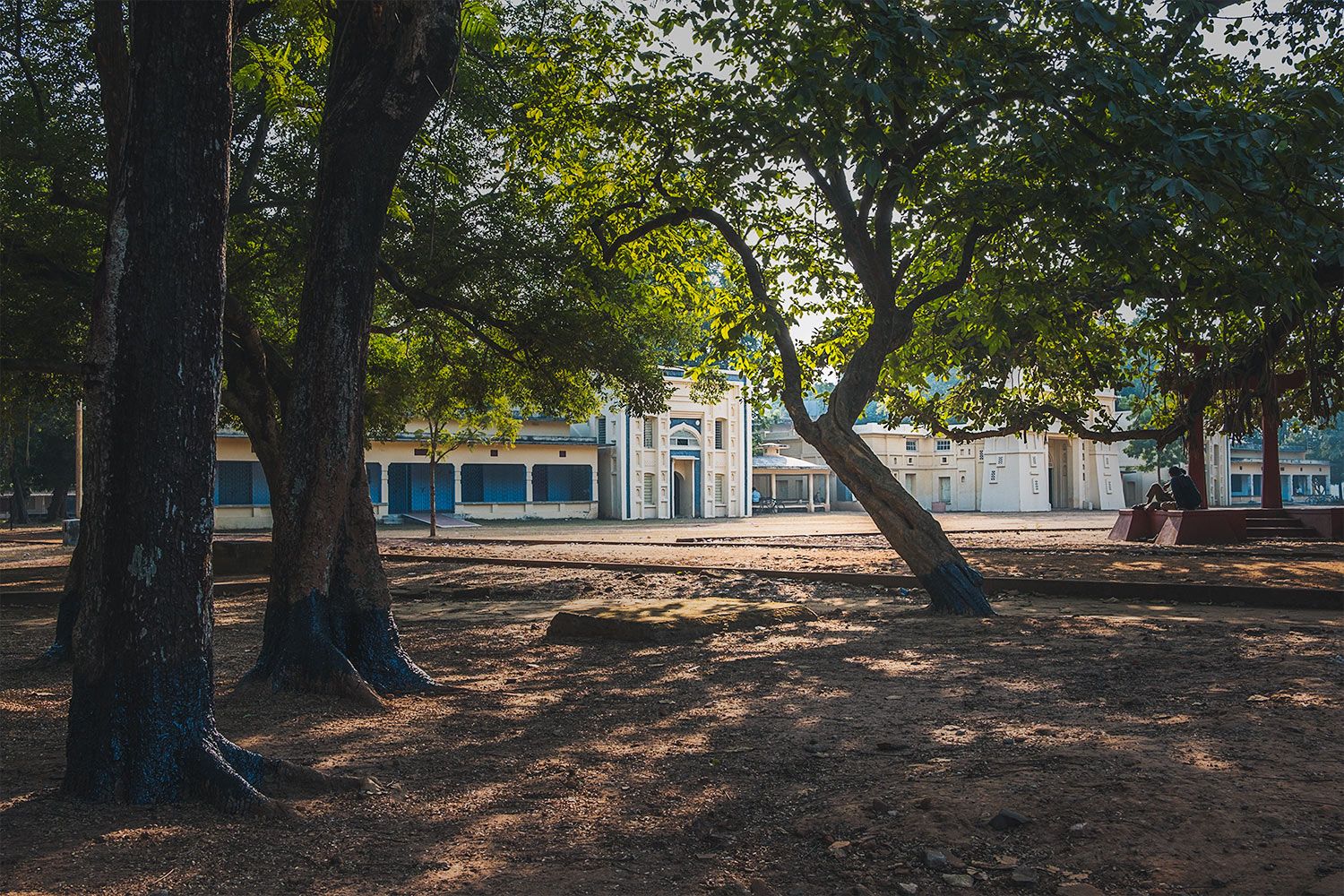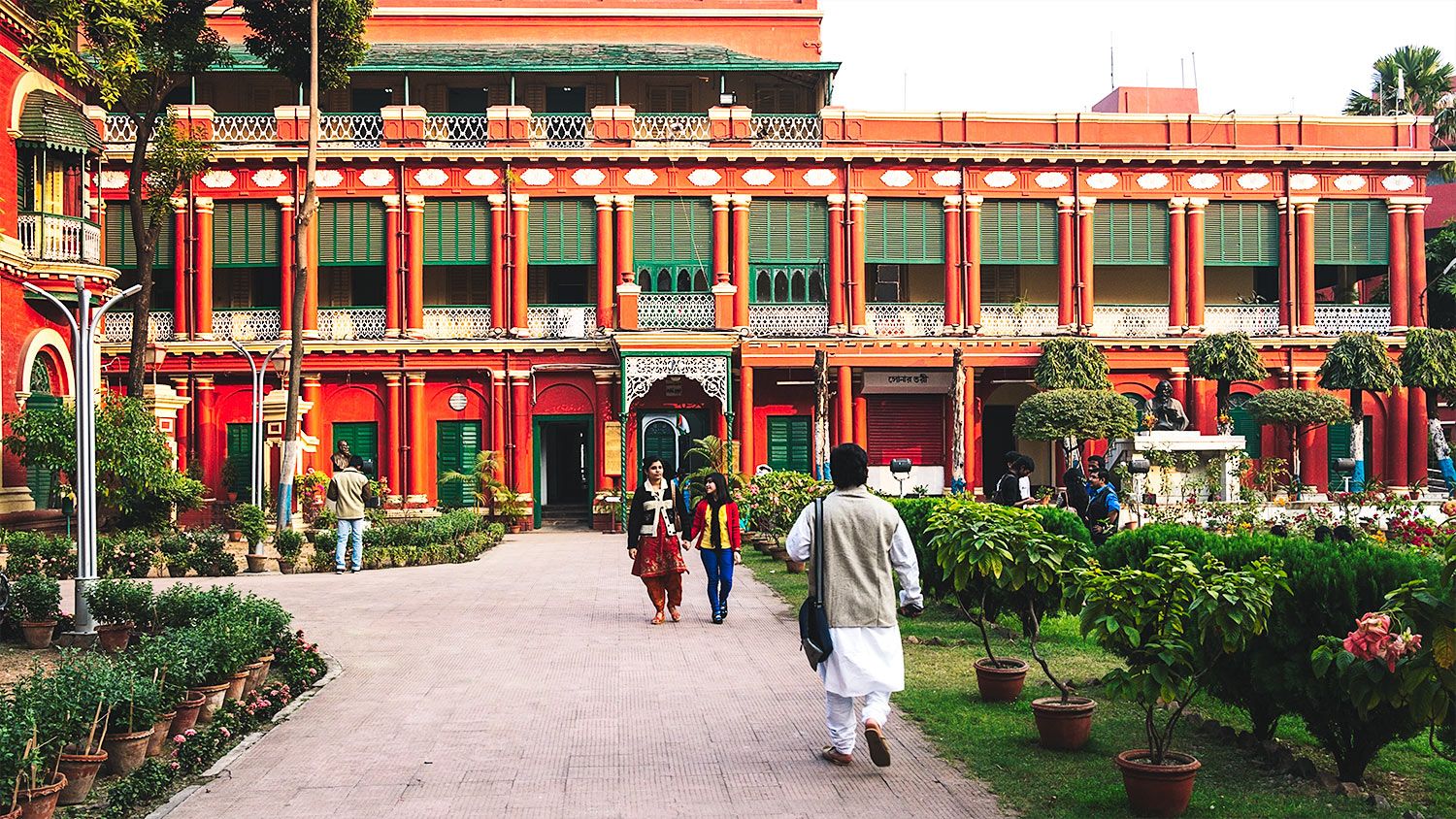Tagore and Shantiniketan
At Shantiniketan, sunny winter had turned the soil dry, and there was dust in the air, and haze, and acres and acres of chiaroscuro carpeting.

This land yields three crops in a year. Conquerors and marauders through centuries have sought wealth derived of it. I gazed at the soil as we passed Singur, black soil on which the Tatas attempted to plant a car factory a few years ago. They were welcomed first and then driven out. Those that sent them packing have reaped plenty of political mileage, my guide told me, even if all that fertile land is bare now and bereft of any crop. I saw heaps of steel all over, the edges of the metal sharp and jagged, a piercing sight. We drove by that awful lot of space a little after dawn, watching sunlight glancing off the exposed, raw parts of metal. It was a sad sight on that otherwise bright and crisp and cheery December morning.
After Singur, the lands are again in productive use. It’s been a year of less-than-satisfactory rain on the subcontinent, and the earth has just delivered the best crop it can under the circumstances. Before us, the land was bare and grey and brown. Rice and potato are the staples as we could see, and there were rice mills along the route that boil rice to suit the local palate; for the potato, there were barns equipped with freezing.
We were driving 200 kilometres to Shantiniketan, half the distance on the Golden Quadrilateral, the rest on the State Highway. For a break, we stopped by a string of stalls selling coffee and tea and mishti. There was a toilet: a room in the back with footrests and you relieved yourself over the flat cement surface between them. Urine flowed round the rests out of the room through a rough-hewn narrow groove, and into a hole outside. It wasn’t too smelly though, and once outside, I was able to push back the experience.
There were no Coffee Cafe Day outlets en route. In recent years that coffee chain has improved the toilet experience on many highways in India.
Approaching Shantiniketan, the terrain changed. The soil was red, and there were woods with sal trees flanking the highway. The air was different as well, with a nip in it in December, and it also carried the strong suggestion of great happenings in these wooded plains. My guide asked permission to make a detour. It took us to a community centre, where there’s a tiny museum, with portraits of men who resisted British rule and were captured and dispatched to the Andamans. Only a very few of those who were sent to the Andamans returned — perhaps those that were alive when the infamous jail was shut down.
Tourists throng to Shantiniketan, most of them Bengali. This is Tagore country. Tall and incredibly striking Rabindranath Tagore is an enduring hero, a beloved son of Bengal, and a visit to his residence and kaaryagaar seems to be a mandatory spiritual excursion for the Bengali. It was Tagore’s father who founded Shantiniketan. Visiting once this area near Bolpur, being tired, he paused for rest among the chhatim trees. The aura of the place struck him, and he perceived in it a future full of great karyas. After losing him, and his wife, and his two children and a friend, all in quick succession, Rabindranath went through a catharsis. He started to engage in intense, focused activities in Shantiniketan.
He didn’t live in one single house during his long residence there. Each time he tired of a current home, he built a new one, and with advancing age he designed progressively smaller houses. Each is a work of art, an excellent place for an artist to live in, and practice art. These days the walls carry pictures of distinguished visitors to these houses. Leaders and intellectuals from the world over visited Tagore in Shantiniketan, through to his last days.
Classes at Shantiniketan are mostly open-air. At 1:00, the classes had ended, and a stroll on the campus was possible. There were few people about, all young, on foot and bicycle. The trees were old, and their bases were fresh-painted black to fight termite. Sunny winter had turned the soil dry, and there was dust in the air, and haze, and acres and acres of chiaroscuro carpeting. “If we’re lucky we might find a Baul,” my guide said, and we did, by the art school. In that school, they’d be studying and creating music of varied styles, and during the time I was there, a group were working on a Bollywood number. The Baul was performing under a tree back of the building, with a dotara, before an audience of two. He was singing already, and we sat down to listen. “The guy’s authentic,” my guide whispered. The strumming, the song, the chill air, the late-afternoon sun — it was all rather like how the world of wine has been described to me.
It was night when we returned to my hotel in Kolkata. “You’re by yourself tomorrow,” by guide said. “You must go to Joransanko Thakur Bari.”
Joransanko Thakur Bari was a palace in red, evidencing the quite-substantial wealth of the Tagore family. Thoughts of wealth lingered only a moment, though, because soon the extent of intellectual and artistic activity during the Bengal renaissance struck me inside the building. And you empathise with the Bengali sentiment for Rabindranath, their Gurudev, their Poet — the P in uppercase when he is referenced. Taking ill in Shantiniketan, he made the last journey from there to Kolkata on an olive green train. Surrounded in this ancestral home by love, and tender, caring hands, and feeling unbearable pain for several days, he died in Joransanko Thakur Bari.
In the courtyard of this home, a stage had been set up for a show scheduled for the evening. The performers were doing last-minute rehearsals. Young fellows standing beneath arches on upper balconies looked down to the women on stage with unabashed longing. The overwhelming impression, however, was of an assured, continued creative effort, stemming from Rabindranath Tagore, everlasting muse for so many creative Bengali people.

